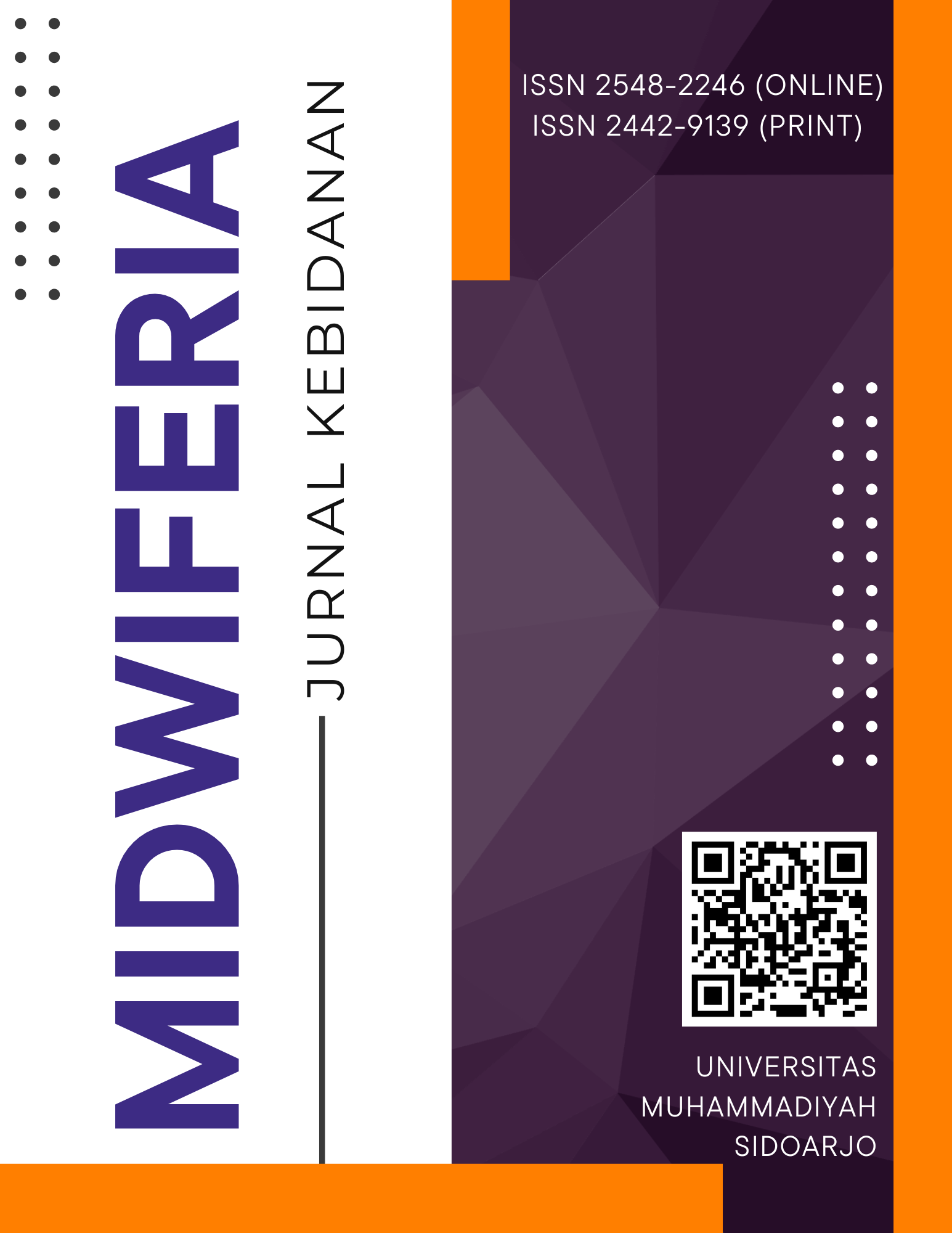The Effect of Moringa Leaf Powder (Moringa Oleifera) on Breast Milk Production in Post Partum Mothers
Pengaruh Bubuk Daun Kelor (Moringa Oleifera) Terhadap Produksi Asi pada Ibu Nifas
Keywords:
ASI, Daun Kelor, Ibu MenyusuiAbstract
Breast milk (ASI) is the main nutrition recommended for newborns. The main obstacle in breastfeeding is the difficulty of breastfeeding because it is not smooth / milk production is disrupted so that exclusive breastfeeding is not achieved, by consuming foods that contain lactogogum is one of the efforts to increase milk production and the success of exclusive breastfeeding. one type of lactogogum that is currently being utilized because this type of plant is easy to plant and easy to get in the family yard is Moringa leaves. Objective: To determine the effect of moringa leaf powder on breast milk production in postpartum mothers in the Serpong 1 South Tangerang Health Center Area in 2023 Methodology: This type of research is quantitative with experimental design. This study used a quacy experimental design with two non-equivalent pretest-posttest groups. Sampling in this study using purposive sampling technique which amounted to 34 respondents. The analysis used is the Wilcoxon and Mann Whitney Test. Research Results: There is an effect of using moringa leaf powder on increasing breast milk production (p value 0.001) in postpartum mothers. Conclusion: Moringa leaf powder can increase breast milk production in postpartum mothers at Serpong 1 Health Center, South Tangerang in 2023. Suggestion: It is expected that moringa leaf powder can be consumed by postpartum mothers to prepare for the breastfeeding period so that they can provide exclusive breastfeeding.
References
Ahsani Rf, Machmud Pb. (2019). The Association Of Reproductive History Eith Breast Tumor In Young Women In Indonesia (Analysis Of Riset Ptm 2016). Media Kesehat Masy Indones. 15(3):237.
Aliyanto W, Rosmadewi. (2019). Efektifitas Sayur Pepaya Muda Dan Sayur Daun Kelor Terhadap Produksi Asi Ibu Post Partum Primipara. Jurnal Kesehat. 10(April):84-92.
Antonio L, Ciampo D, Regina I, Del L. (2018). Breastfeeding And Thebenefit Of Lactation For Women’s. 40(6):354-359.
Anggraini Rd, Soejoenoes A, Supriyana. (2019). Unripe Carica Papaya L. Exstract As An Alternative For Midwifery Services In Primipara Post Partum Mother For Breast Milk Adequacy. Int J Sci Res. 8(1):2018-2020.
Arikunto, S. (2019). Prosedur Penelitian. Jakarta : Rineka Cipta.
Bahriyah I, Haryati A, Zayadi H. (2015). Studi Etno Botani Tanaman Kelor (Moringa Oleifera) Di Desa Somber Kecamatan Tambelangan Kabupaten Sampang Madura. E-Jurnal Ilm Biosaintropis.2805(1):61-67.
Darma Arp, Timbuleng Emlm, Azzahroh N,Khasanah Pu, Arofah Ge,Kartikasari Mnd. (2019). Peri Dalor (Permen Jeli Daun Kelor): Inovasi Permen Kaya Antioksidan Sebagai Solusi Kesehatan. J Semar . 8(1):35-39.
Erlinawati, Amir Hf, Pueri Ad. (2019). Hubungan Frekuensi Pemberian Asi Pada Ibu Menyusui Dengan Peningkatan Berat Badan Bayi. J Doppler. 3(2):9- 17.
Global Breastfeeding Colective. (2018). Enabling Women Brestfeed Through Betterpolicies And Call To Action Priorites
Indrasari, N. (2015). Hubungan Frekuensi Menyusui Dengan Involusi Uterus Pada Ibu Nifas. J Keperawatan. Xi(1):27-32).
Irwan Z, Salim A, Adam A. (2020). Pemberian Cookies Tepung Daun Dan Biji Kelor Terhadap Puskesmas Tampa Padang. Aceh Nutr J. 5(1):45-54.
Jayanti, I. (2019). Evidance Based Dalam Praktek Kebidanan. Pertama. Yogyakarta: Deepublish.
Johan H,Anggraini Rd, Noorbaya, S. (2019). Potensi Daun Kelor Terhadap Peningkatan Produksi Asi Pada Ibu Post Partum. Sebatik.23(1):192-194.
Krisnadi, Ad. (2015). Kelor, Super Nutrisi. Blora.
Lauwers, J. (2016). Quick Reference For The Lactation Profesional. 2nd Revise. United States:Jones & Barlett Publisher.
Ma Zf, Ahmad J, Zhang H, Khan I, Muhamad S. (2018). Evaluation Of Phytocemical And Medicinal Properties Of Moringa Oleifera As A Potential Food. South African J Bot.129:40-46.
Marati U, Aziza N. (2018). Hubungan Menyusui Eksklusif Dengan Involusi Uteri Pada Ibu Post Partum Di Kota Bandar Lampung. J Keperawatan. Xiv(1):116-122.
Mosca F, Gianni Ml. (2017). Human Milk: Composition And Health Benefits. La Pediater Medica E Chir. 39(155):47-52.
Mutiara, T. (2011). Uji Efek Pelancar Asi Tepung Daun Kelor Pada Tikus Putih Galur Wistar. (November).
Nurbaiti, M. (2018). Hubungan Pemberian Asi Terhadap Berat Badan Bayi Di Wilayah Kerja Puskesmas Sematang Borang Palembang. J Aisyiah Med. 1(2):108-118.
Nurhayati I, Maulida I, Chikmah Am. (2013). Hubungan Pola Nutrisi Pada Ibu Nifas Dengan Kecukupan Asi Pada Bayi Di Desa Mejasem Timur Kecamatan Keramat Kabupaten Tegal. J Res Midwifery Politek Tegal. 3(1):1-8.
Notoatmodjo. (2018). Prosedur Penelitian. Jakarta : Rineka Cipta.
Peraturan Pemerintah Republik Indonesia Nomor 33 Tahun (2012).
Pranajaya R, Rudiyanti N. (2013). Determinan Produksi Asi Pada Ibu Menyusui. J Keperawatan. Ix(2):227-237).
Rahmadani Pa, Widyastuti N, Fitranti Dy, Wijayanti Hs. (2020). Asupan Vitamin A Dengan Tingkat Kecemasan Merupakan Faktor Resiko Kecukupan Produksi Asi Pada Ibu Menyusui Bayi Usia 0-5 Bulan. J Nutr Coll. 9(1):44-53.
Rahmawati A, Prayogi B. (2017). Analisis Faktor Yang Mempengaruhi Produksi Asi Pada Ibu Menyusui Yang Bekerja. J Ners Dan Kebidanan. 4(2):134- 140.






